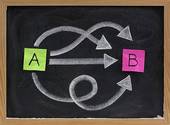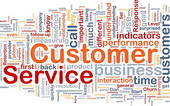Customer Pathways (Inward)
Aim
For participants to consider and appreciate the different ways in which customers have contact with the organisation, and their role in providing customer service.
Overview
Having mapped out the pathways that customers follow, participants think about their own responsibility in making that route as smooth as possible.
Numbers
Any number working in groups of three to six.
Suitable for
Induction, refresher, short session in a longer training, team meeting activity.
What you need
One sheet of flipchart paper per group plus pens.
Resource 1 – Customer Pathways
Handout 1 – The Brief
Handout 2 – Action Plan
Handout 3 – Report Back (for evaluation)
Preparation
- Copy Handout 1 – The Brief (one per group)
- Copy Handout 2 – Action Plan (one per person)
- (Optional) copy Resource 1 – Customer Pathways to use as a handout
- Arrange the room so that participants can work in groups of three to six people.
What to Do
Activity – 2 minutes – groups
Give each group of participants a sheet of flipchart paper and a selection of pens.
Also give them a copy of Handout 1 – The Brief.
Ask them to complete stage one of the exercise by mapping out the different routes that customers take when coming into contact with this organisation.
Reflect – 3 minutes – groups
Refer the groups to stage two of the brief and ask them to reflect on the impact that they can have personally on each of the customer pathways.
If any of the groups feel that they do not have any responsibility for some of the pathways you should challenge them to find some way in which they do. Use Resource 1 – Customer Pathways to help you.
Conclude – 3 minutes – whole group
Collect feedback from each of the groups and gain consensus on the ways that individuals impact on the various different customer pathways.
If appropriate use Resource 1 – Customer Pathways as a handout.
Plan – 2 minutes – individual
Give each individual a copy of Handout 2 – Action Plan and ask them to record the action that they plan to take as a result of this training session.
Evaluation
Three weeks after the training session send each participant a copy of Handout 3 – Report Back, asking them to complete and return it.
Variation
f you have plenty of floor space, you could physically ‘map out’ the pathways that customers take and have groups of participants ‘walk through’ the exercise discussing their role along each ‘route’.
Customer Pathways (Inwards)
Resource 1 – Customer Pathways
Use this resource to prompt the responses from the groups during the exercise.
Feel free to add or amend sections according to your knowledge of the organisation and its customers.
| Personal visit |
|
| Letter |
|
| Telephone |
|
|
|
| Website |
|
| Social media |
|
| Order form |
|
Customer Pathways (Inwards)
Handout 1 – The Brief
Stage One
On the sheet of paper that you have been given:
- Draw a shape in the centre that represents your organisation
- Draw lines into the centre which represent the different ways in which customers make contact with your organisation
Stage Two
Now think about the impact that you personally can have on the level of customer service that is delivered along each of the pathways that you have drawn.
Make notes of your main points on the sheet of paper.
Customer Pathways (Inwards)
Handout 2 – Action Plan
As a result of this training session I have decided to:
By (date):
The effect this will have is:
Signed:
Date:
Customer Pathways (Inwards)
Handout 3 – Report Back
Following this training session the action I took was:
The result it had was:
I now intend to:
Signed:
Date:
Please complete this form and return it to:
By (date):








